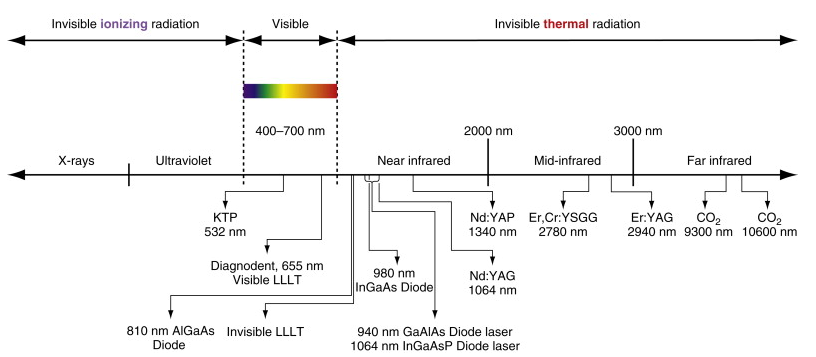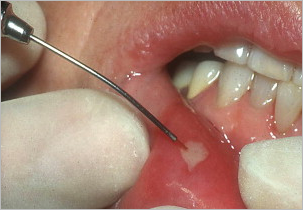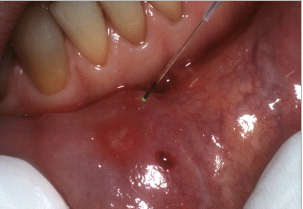

As waves travel, they rise and fall about the zero axis a certain number of times per second; this is called oscillation. The number of oscillations per unit time is defined as frequency. Frequency is measured in hertz (Hz); 1 Hz equals one oscillation per second. Frequency is inversely proportional to wavelength: The shorter the wavelength, the higher the frequency, and vice versa. Although the hertz as just defined is a basic unit in physics, it also is used more specifically to describe the number of pulses per second of emitted laser energy.
Ordinary light, such as that produced by a table lamp, usually is a warm, white color. “White” as seen by the human eye is really the sum of the many colors of the visible spectrum: red, orange, yellow, green, blue, and violet. The light usually is diffuse—that is, not focused. Laser light is distinguished from ordinary light by two properties. Laser light is monochromatic : It is generated as a beam of a single color, which is invisible if its wavelength is outside of the visible part of the spectrum. In addition, the waves of laser light are coherent , or identical in physical size and shape.dental laser Thus the amplitude and frequency of all of the waves of photons are identical. This coherence results in the production of a specific form of focused electromagnetic energy.
The beams emitted from laser instruments are collimated (produced with all waves parallel to each other) over a long distance, but once the laser beam enters certain delivery systems such as optical fibers or tips (e.g., in neodymium-doped yttrium-aluminum-garnet [Nd:YAG], erbium, and diode lasers), it diverges at the fiber tip. This monochromatic, coherent beam of light energy can be used to accomplish the treatment objective.

Using a household fixture as an example, a 100-watt (W) lamp will produce a moderate amount of light for a room area, with some heat. On the other hand, 2 W of laser light can be used for precise excision of a fibroma while providing adequate hemostasis at the surgical site, without disturbing the surrounding tissue. The difference between the 100 W of an ordinary light bulb able to light up a room and the 2 W of a laser able to perform a surgical procedure lies in the property of coherence. As an apt analogy, imagine a crew race on a river. The boat that comes in first is the boat in which all of the members of the crew team are working together. At any given moment, they are all at the same stage of the stroke cycle, so that all of their energies are working together to propel the boat. All of the members of the crew team place their oars in the water at the same instant. They all remove their oars from the water at the same instant. They are working together in perfect unison. In similar fashion, all of the light waves in a laser work together in a beam of coherent energy. By contrast, in the boat that comes in last, the crew members may be seen to be at different stages of the stroke cycle. Some have their oars going into the water, and some have their oars coming out of the water; some are at the top of the stroke cycle, and some are at the bottom of the stroke cycle. The team members are not working together as one. The work expended by this disorganized crew, which cannot propel their boat forward with any effective speed, would be analogous to the energy from an ordinary light bulb, which is insufficient for excision of soft tissue.

The light waves produced by the laser are a specific form of electromagnetic energy.
The electromagnetic spectrum is the entire collection of wave energy, ranging from gamma rays, with wavelengths of 1 x 10 −12 m, to radio waves, with wavelengths of thousands of meters. All currently available dental laser devices have emission wavelengths of approximately 500 to 10,600 nm, which places them in either the visible or the invisible (infrared) nonionizing portion of the electromagnetic spectrum . Of note, the dividing line between the ionizing, cellular DNA–mutagenic portion of the spectrum and the nonionizing portion is at the junction of ultraviolet and visible-violet light. Thus all current dental lasers emit either a visible-light wavelength or an invisible, infrared-light wavelength in the portion of the nonionizing spectrum called thermal radiation. The word radiation in this context does not imply radioactive or carcinogenic but simply means the emission of electromagnetic energy .Laser energy should be delivered to the surgical site by a method that is ergonomic and precise.
Shorter-wavelength instruments, such as KTP, diode, and Nd:Y-AG lasers, have small, flexible fiberoptic systems with bare glass fibers that deliver the laser energy to the target tissue. Because the erbium and CO 2 laser wavelengths are absorbed by water, which is a major component of conventional glass fibers, these wavelengths cannot pass through these fibers. Erbium and CO 2 devices are therefore constructed with special fibers capable of transmitting the wavelengths, with semiflexible hollow waveguides, or with articulated arms . Some of these systems employ small quartz or sapphire tips that attach to the laser device for contact with target tissue; others employ noncontact tips . In addition, the erbium lasers incorporate a water spray for cooling hard tissues. Lasers may have different fiber diameters, handpieces, and tips. Each of these elements plays a significant role in the delivery of energy .The appropriate and effective use of dental lasers in clinical practice requires a firm grasp of their scientific basis and tissue effects, proper training in techniques and applications, and sufficient operative experience to achieve and maintain proficiency. The clinician can then choose the proper laser(s) for the intended application. Although the types of tissue interaction overlap somewhat, each wavelength has specific properties that can be used to accomplish a specific treatment objective. Laser energy requires some procedures to be performed much differently from those using conventional instrumentation, but the indications for laser use continue to expand, with further benefit for patient care.